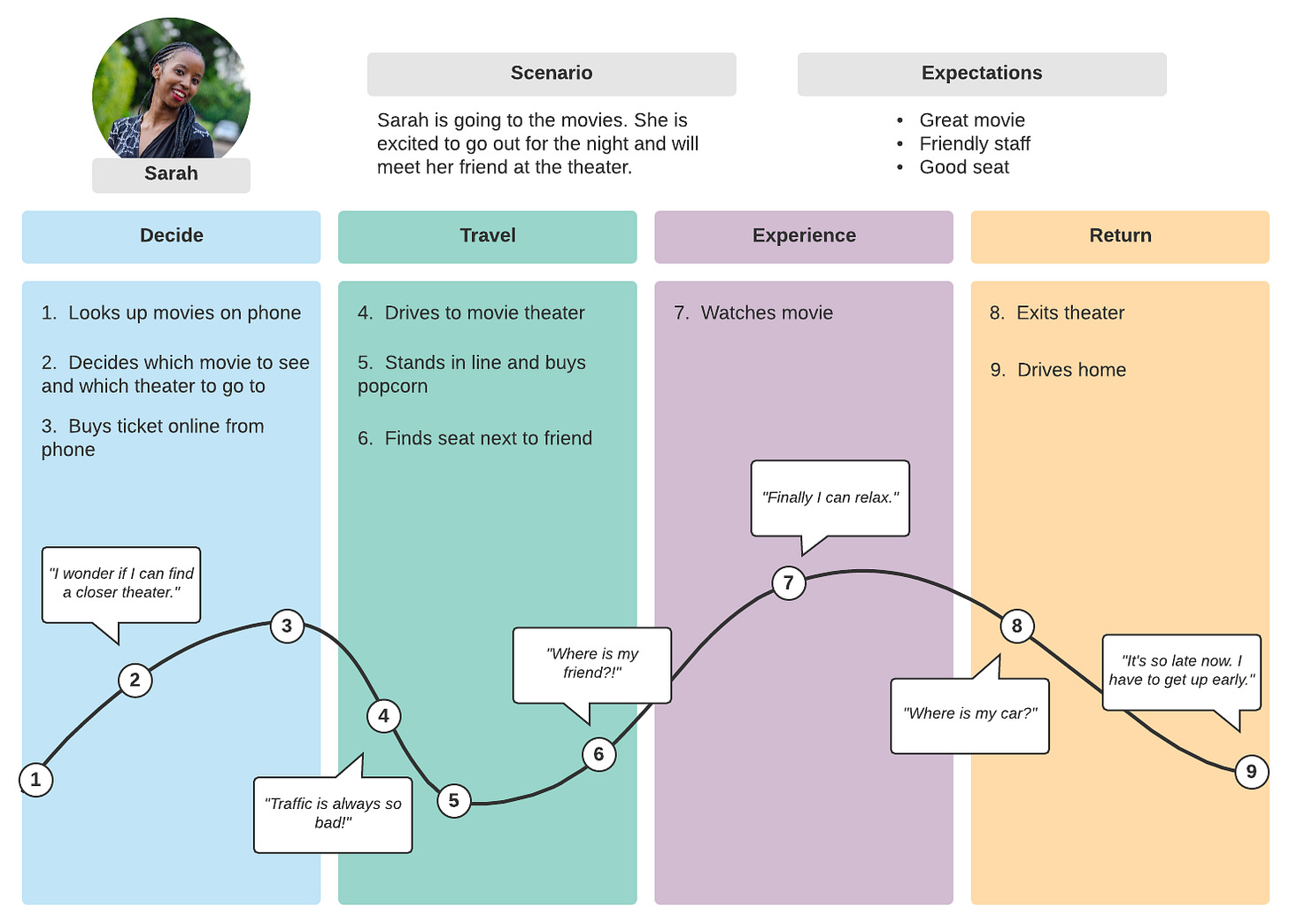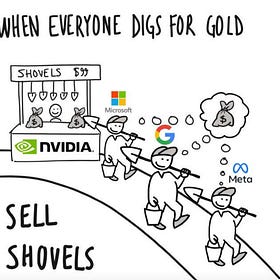Traditional Customer Journeys vs. AI Decisioning
Why I Was Wrong (and What’s Next)
Back in Q3 2023, I took a stab at predicting AI’s impact on marketing in my MarTech for Humans newsletter.
I said customer journey management might feel AI’s influence within five years.
I figured areas like AdTech, Social Media Marketing, and Content Marketing would get the AI treatment first, while Customer Experience (which includes journey management) was a coin toss.
Well, with revelations that undermined the data foundation of AdTech & new AI journey tooling, it looks like I had it flipped1.
Less than two years later, companies like TheyDo and Hightouch are proving me wrong with AI Decisioning tools that are already rewriting the rules for lifecycle marketers.
What’s the situation with traditional customer journey building versus AI Decisioning?
Where did I misjudge, and what’s coming next?
Traditional Customer Journey Building: The Paper Map Approach
Imagine you’re planning a cross-country road trip with a trusty paper map.
You trace the route with a highlighter, mark your gas stops, and plan your diner breaks.
That’s traditional customer journey building.
You, the marketer, design every step by using past data and your experience to create a journey—email one goes out on day one, a push notification follows 30 minutes later if they click, and a discount code drops if they don’t buy by day 5.
It’s a neat little flowchart with “if/else” branches that guide a customer along your path, except you’re the one stuck with writing every ending—and keeping track of all the business rules.
It’s predictable, like a train rolling down fixed tracks.
You’ve got total control over the messaging, timing, and brand vibe.
But here’s the rub: it doesn’t change when your customers do.
If customer behavior veers off your carefully plotted path, you’re stuck manually updating every single pathway.
Even worse, if you haven’t set up good testing, you can have customers trapped—you’re left with frustrated customers and a headache.
Pros of Traditional Journeys
Predictable: You know exactly what’s happening at every turn.
Total Control: Every subject line, image, and send time is yours to command.
Cons of Traditional Journeys
Static: No real-time detours without manual rework.
Time-Intensive: Building and tweaking these flows eats time—days, even.
Limited Experimentation: A/B testing? Sure, if you’ve got the bandwidth to set it up and wait.
When to Use It
Stick with traditional journeys for:
Transactional Messages: Order confirmations, shipping updates—stuff that needs precision.
Educational Sequences: Onboarding flows where exact order matters, like “Welcome” then “How to Use This Thing.”
Short-Term Campaigns: Think Black Friday blasts—anything that has strong seasonality effects shouldn’t be thrown to AI2
AI Decisioning: The GPS Revolution
Now, ditch the paper map and imagine a GPS that’s not just guiding you but rethinking the route with every turn. That’s AI Decisioning. You tell it where you want to go (say, more conversions or higher retention), hand over your content and some guardrails, and let it loose. It figures out the best channel, message, and timing for each customer—on the fly—using reinforcement learning and AI smarts.
If traditional journeys are trains on tracks, AI Decisioning is a fleet of self-driving cars. Every customer gets a bespoke ride, tweaking itself based on their behavior, history, and vibes. It’s always learning, testing, and optimizing, like a marketing assistant who never sleeps. But—here’s the kicker—it’s less predictable. You’re not scripting every move; you’re trusting the AI to pick the right ones. It’s like handing the keys to a teenager with a shiny new Tesla—you’re a bit nervous, but the tech’s got this.
Pros of AI Decisioning
1:1 Personalization: Tailored messages, channels, and timings for every customer.
Self-Improving: It experiments and gets better without you micromanaging.
Outcome-Oriented: Focused on your goals—sales, loyalty, whatever—over rigid rules.
Cons of AI Decisioning
Less Predictable: You set the options; AI picks the play.
Learning Curve: It needs time to ramp up, so short sprints aren’t its forte.
When to Use It
AI Decisioning shines for activities that generate lots of data—browsing and purchase behavior give AI more fuel than year-over-year trends on a cohort.
Repeat Purchases: Hyper-targeted product nudges based on what they’ve bought or browsed.
Loyalty Programs: Personalized perks to keep customers hooked.
Cart Abandonment: Dynamic tests to lure them back—email now or text later? Braze has been doing this for years
Cross-Sell/Upsell: Suggesting the next best thing at the perfect moment.
Winback Campaigns: Re-engaging lapsed folks with offers they can’t ignore.
How To Make Your AI Projects Fail 100% of the Time
Remember that data quality matters more than anything else!!
Where I Went Wrong in 2023
In that September 2023 article, I thought AI would take longer to crack customer journey management.
I saw it as too complex and ill defined for machines to master quickly.
I figured we’d need years of fine-tuning before AI could handle the messiness of customer behavior (outside of very controlled situations like Braze’s Timing tool).
But it looks like I was off.
Tools for AI Decisioning are already here, using reinforcement learning to navigate that complexity faster than I expected.
Will it be a forgotten attempt at tooling? or will it be driving lifecycle marketing at scale?
If I had to guess, it’s going to stick around.
Choosing Your Tool: Map or GPS?
So, which do you pick? It’s about the right fit.
Traditional Journeys are your go-to for campaigns needing precision and control. If you only have data for who attended a physical event and who bought in the next quarter—you probably don’t have the resolution you need for an AI tool. Stick with traditional
AI Decisioning is for personalized, always-on optimization. If you have a huge (cleaned!!) database with customer interactions, Ai will do much better at discovering new segments and building journeys.
Hightouch’s article nails it: use predefined journeys for structured, predictable stuff, and AI Decisioning for dynamic, scalable personalization.
What’s Next?
Here’s my new prediction (with a dash more humility): we’re headed for a hybrid world. Marketers won’t ditch journeys or go all-in on AI—they’ll blend them.
But the biggest changes will be in how much freedom AI is given. It’s currently held on a pretty tight leash (for good reason), but there are some cool directions that let you take off the reigns.
Check out how Ramp thinks through AI tooling and throws more compute to solve edge cases.
The Takeaway
You’re not stuck picking sides. Use traditional journeys for the predictable stuff—transactional emails, onboarding flows—and let AI Decisioning loose on the messy3, personal campaigns like loyalty or winbacks.
Kinda, I was totally right on AI use in content and social media marketing.
yet
non-critical




